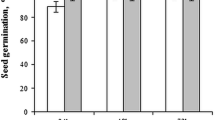Abstract
The seeds of wheat variety UP 2565 were invigorated with static magnetic fields of 100- and 200-mT intensities for 1 h and hydropriming for 16 h. Seedling vigour and enzyme activities of all invigorated seeds along with untreated control were conducted in the laboratory. Seedling vigour parameters were significantly higher in invigorated seeds than that of untreated seeds. Among invigorated seeds, hydroprimed seeds took minimum time to emerge than magnetically treated seeds. Similarly root length, shoot length, seedling vigour index were also significantly higher in hydroprimed seeds than magnetically treated seeds. The magnetic treatments led to a significant increase in shoot length, root length, seedling dry weight, vigour index and enzyme activity in comparison with untreated seeds. Alpha amylase activity was also 2.7, 1.8 and 1.3 times higher in hydroprimed, 100- and 200-mT static magnetic field treatments, respectively, over untreated seeds. Electrical conductivity of seed leachate was significantly reduced by hydropriming and static magnetic field treatments. At higher magnetic field, seedling vigour and enzyme activity were reduced.



Similar content being viewed by others
References
Abbasdokht H (2011) Effect of hydropriming and halopriming on germination and early growth stage of wheat (Triticum aestivum L.). Desert 16:61–68
Abdul-Baki AA, Anderson JB (1973) Vigour determination in soybean seed by multiple criteria. Crop Sci 13:630–632
Ahmadi A, Mardesh AS, Poustini K, Jahromi ME (2007) Influence of osmo and hydropriming on seed germination and seedling growth in wheat (Triticum aestivum L.) cultivars under different moisture and temperature conditions. Pak J Biol Sci 10(22):4043–4049
Aladjadjiyan A (2002) Study of the influence of magnetic field on some biological characteristics of Zea mais. J Central Euro Agric 3(2):89–94
Alajadjiyan A (2010) Influence of stationary magnetic field on lentil seeds. Int Agrophys 24(3):321–324
Ashraf M, Foolad MR (2005) Pre-sowing seed treatment—a shotgun approach to improve germination, plant growth and crop yield under saline and non-saline conditions. Adv Agron 8:223–271
Bujrukh MS (2011) Influence of magnetic field intensity on seed quality attributes of cereal crops. M.Sc. thesis University of Agriculture sciences Dharwad
De Souza A, Garcia D, Sueiro L, Gilbert F, Licea L, Porras E (2006) Pre sowing magnetic treatment of tomato seeds increase the growth and yield of plants. Bioelectromagn Biol Med 27:173–184
Farooq M, Basra SMA, Hafeez-u-Rehman Saleem BA (2008) Seed priming enhances the performance of late sown wheat (Triticum aestivum L.) by improving chilling tolerance. J Agron Crop Sci 194(1):55–60
Florez M, Carbonell MV, Martinez E (2004) Early sprouting and first stages of growth of rice seeds exposed to a magnetic field. Electromagn Biol Med 23(2):167–176
Girish K, Yadav SK, Lal SK, Jain SK, Shantha N (2011) Static magnetic field treatment enhances seed performance in cotton (Gossypium hirsutum L.). Seed Res 39(2):124–129
Gomez KA, Gomez AA (1984) Statistical procedures for agricultural research. An International rice research book, II edn. A Wiley Interscience Publication, New York
Government of India (1993) Department of Agriculture and Cooperation, Ministry of Agriculture. In: Agrawal PK (ed) Handbook of seed testing, Department of Agriculture & Cooperation, Ministry of Agriculture, Goverment of India. New Delhi
ISTA (2004) International rules for seed testing. International Seed testing Association Zurich, Switzerland
Kittock DL, Law AG (1968) Relationship of seedling vigour to respiration and tetrazolium chloride reduction by germinating wheat seeds. Agron J 60:286–288
Mahajan TS, Pandey OP (2014) Magnetic-time model at off-season germination. Int Agrophys 28:57–62. doi:10.2478/intag-2013-0027
Mazumdar BC, Mazumdar K (2003) Method on physico chemical analysis of fruits. Daya Books, p 187. ISBN: 8170352886, ISBN: 9788170352884
Mc Donald MB (1999) Seed deterioration: physiology, repair and assessment.Seed. Sci Technol 27:177–237
McDonald M, Nelson CJ (1986). Physiology of seed deterioration. In: Proceedings of symposium crop science society of America, November Madison, Wisconsin, USA, p 123
Payez A, Ghanati F, Behmanesh M, Abdolmaleki P, Hajnorouzi A, Rajabbeigi E (2013) Increase of seed germination, growth and membrane integrity of wheat seedlings by exposure to static and a 10-KHz electromagnetic field. Electromagn Biol Med 32(4):417–429
Phirke PS, Kubde AB, Umbakar SP (1996) The influence of magnetic field on plant growth. Seed Sci Technol 24:375–392
Racuciu M, Creanga D, Horga I (2006) Plant growth under static magnetic field influence. Rom J Phys 53:353–359
Samani MA, Pourakbar L, Azimi N (2013) Magnetic field effects on seed germination and activities of some enzymes in cumin. Life Sci J 10(1):323–328
Vashisth A, Nagarajan S (2010) Characterization of water distribution and activation of enzymes during germination in magnetically exposed maize (Zea mays) seeds. Indian J Biochem Biophys 47:311–318
Vashisth A, Nagarajan S (2010) Effect on germination and early growth characteristics in sunflower (Helianthus annuus) seeds exposed to static magnetic field. J Plant Physiol 167:149–156
Acknowledgements
Authors are grateful to director experiment station, Pantnagar, for providing financial assistance to conduct the experiment. The authors are also thankful to Head, Department of Agronomy and Head, Department of Physics, for providing necessary facilities during course of studies.
Author information
Authors and Affiliations
Corresponding author
Rights and permissions
About this article
Cite this article
Verma, O., Joshi, N., Pandey, S.T. et al. Comparative Study of Hydropriming to Static Magnetic Field on Seedling Vigour and Enzyme Activity in Wheat Seed. Agric Res 6, 235–240 (2017). https://doi.org/10.1007/s40003-017-0274-6
Received:
Accepted:
Published:
Issue Date:
DOI: https://doi.org/10.1007/s40003-017-0274-6




